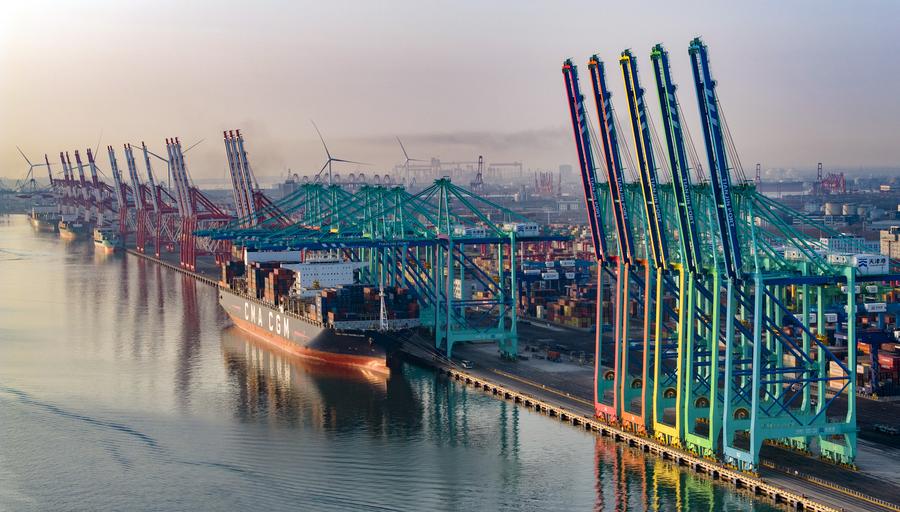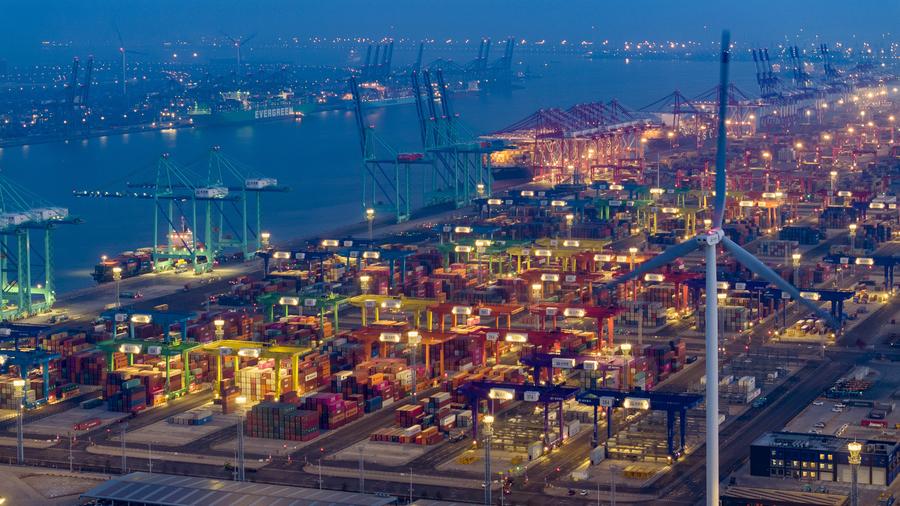Explainer: How port cooperation helps enterprises in Beijing-Tianjin-Hebei region go abroad

An aerial drone photo taken on Feb. 2, 2024 shows a container vessel berthing at the smart zero-carbon terminal of Tianjin Port in north China's Tianjin. (Xinhua/Zhao Zishuo)
Since the coordinated development of the region was proposed as a national strategy in 2014, cooperation and coordination between the ports in Tianjin and Hebei have been gaining momentum.
XIONG'AN, China, March 2 (Xinhua) -- When discussing the coordinated development of the Beijing-Tianjin-Hebei region over the past decade, Shen Xifeng, a 50-year-old entrepreneur in the Xiong'an New Area, highlighted port cooperation.
"The port service on the doorstep has significantly reduced the time required to export our products," Shen said, referring to Tianjin Port Group's service center in the Xiong'an New Area, a 1,770-square-km area some 100 km southwest of Beijing that was established on April 1, 2017.
Established in 2019, the center aims to provide efficient port and logistics services for enterprises in Xiong'an and its surrounding areas. Last month, the center successfully assisted Shen's company, Xiongxian Liya Packing Material Co., Ltd, in avoiding a possible default.
Before the Chinese New Year, the packing material company planned to export a container of stretch film to Le Havre in France.
However, the cold weather and a surge in demand for other products caused a delay in the production of the stretch film. If the container could not be delivered on time, the company would face not only a claim for compensation by its foreign customers, but also a tarnished reputation in overseas markets.

An aerial drone photo taken on Feb. 3, 2024 shows a container terminal of Tianjin Port in north China's Tianjin. (Xinhua/Zhao Zishuo)
Upon learning about the problem faced by Liya company, Tianjin Port Group's service center in Xiong'an immediately coordinated shipping companies, transport operators, port terminals and customs, further streamlining the export process. Finally, the container of the stretch film departed from Tianjin Port on Feb. 13 as scheduled.
"Thanks to the service center, our communication (with Tianjin Port) has significantly improved in terms of convenience and efficiency. The timely delivery of our export goods has boosted customers' trust in our company, laying a solid foundation for expanding our overseas businesses," Shen said.
Zhao Shuo, responsible for the service center, highlighted Liya's story as another testament to Tianjin Port's commitment to providing high-quality service for the development of Xiong'an, an area which China aims to build into a green, innovative city and a national model of high-quality development.
"The establishment of the center also represents a tangible step taken by Tianjin Port to promote the coordinated development of the Beijing-Tianjin-Hebei region," Zhao added.
In addition to setting up the service center in Xiong'an, Tianjin Port also inaugurated a service center to coordinate port services for Beijing's CBD in 2023.
Similarly, Hebei Port Group has also implemented programs to better serve regional enterprises seeking international expansion. Figures provided by the group showed that it has set up nearly 20 inland ports in the Beijing-Tianjin-Hebei region.
Since the coordinated development of the region was proposed as a national strategy in 2014, cooperation and coordination between the ports in Tianjin and Hebei have been gaining momentum.
In May 2023, Tianjin Port Group and Hebei Port Group signed a cooperation agreement to enhance the radiating and driving roles of ports, and to provide robust support for the coordinated development of the Beijing-Tianjin-Hebei region.

An aerial drone photo taken on Feb. 2, 2024 shows a cargo ship sailing in the main channel of Tianjin Port in north China's Tianjin. (Xinhua/Zhao Zishuo)
Over the past years, the ports have given full play to their respective advantages and complemented each other.
For example, while Tianjin Port handles more exports destined for distant destinations, Qinhuangdao Port, under Hebei Port Group, focuses on export routes to South Korea and Japan. A ship carrying both passengers and cargo departs from Qinhuangdao Port to Inchon in South Korea every Wednesday and Sunday.
"The route provides a strong logistics guarantee for expanding our company's business in the South Korean market," said Zhao Jinxing, head of the foreign trade department of Qinhuangdao Lihua Starch Co., Ltd.
Meanwhile, feeder vessels are now shuttling between the ports in Hebei and Tianjin. The vessels have ensured that the ports can share each other's route resources and transport capacity.
"The feeder vessels are like shuttle buses," Zhao explained, "they can transfer products between ports in the most effective way."
Port cooperation in the region has facilitated the company's global expansion. Zhao said the company has exported its products to more than 100 countries and regions each year, noting that port cooperation "has reduced our costs and increased efficiency for export."
Photos
Related Stories
- What China has got over a decade on its iconic coordinated regional development strategy?
- China's Tianjin launches 1st roadway for intelligent connected vehicles
- How China's '15-minute Community Life Circle' initiative improves people's lives
- Snow scenery in Beijing
- Parts of China brace for heavy snowfall
- Integrated transportation hub of Beijing sub-center under construction
Copyright © 2024 People's Daily Online. All Rights Reserved.









